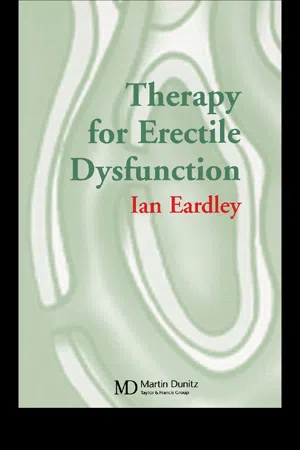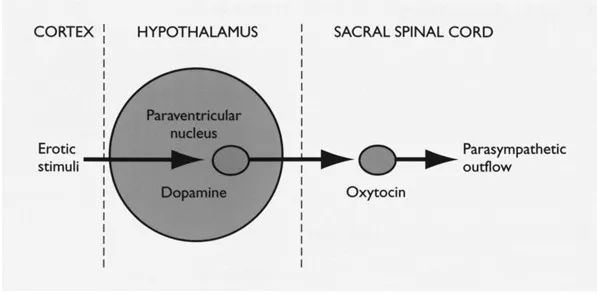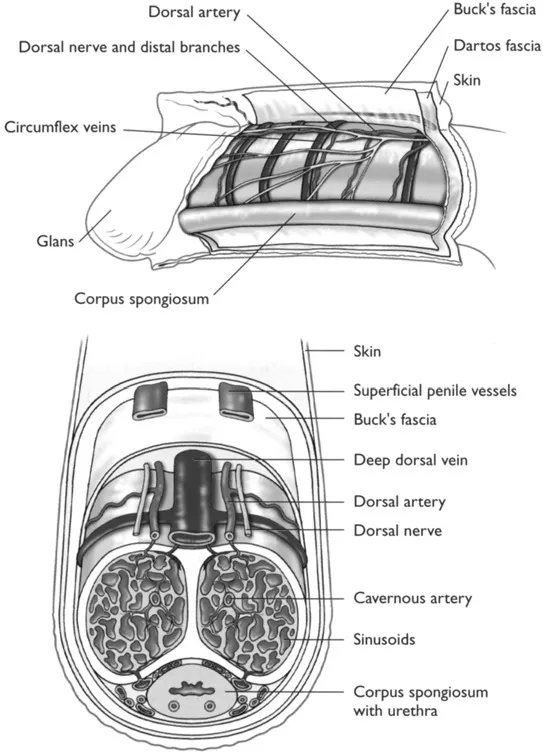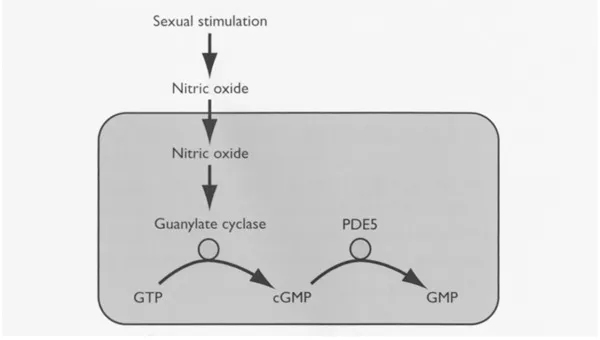
- 72 pages
- English
- ePUB (mobile friendly)
- Available on iOS & Android
eBook - ePub
Therapy for Erectile Dysfunction: Pocketbook
About this book
Erectile dysfunction is a common problem that may result from a number of medical conditions. With increasing public awareness, men with ED are seeking medical help. This pocketbook will assist the physician in treating and managing ED effectively with either drugs or devices.
Frequently asked questions
Yes, you can cancel anytime from the Subscription tab in your account settings on the Perlego website. Your subscription will stay active until the end of your current billing period. Learn how to cancel your subscription.
No, books cannot be downloaded as external files, such as PDFs, for use outside of Perlego. However, you can download books within the Perlego app for offline reading on mobile or tablet. Learn more here.
Perlego offers two plans: Essential and Complete
- Essential is ideal for learners and professionals who enjoy exploring a wide range of subjects. Access the Essential Library with 800,000+ trusted titles and best-sellers across business, personal growth, and the humanities. Includes unlimited reading time and Standard Read Aloud voice.
- Complete: Perfect for advanced learners and researchers needing full, unrestricted access. Unlock 1.4M+ books across hundreds of subjects, including academic and specialized titles. The Complete Plan also includes advanced features like Premium Read Aloud and Research Assistant.
We are an online textbook subscription service, where you can get access to an entire online library for less than the price of a single book per month. With over 1 million books across 1000+ topics, we’ve got you covered! Learn more here.
Look out for the read-aloud symbol on your next book to see if you can listen to it. The read-aloud tool reads text aloud for you, highlighting the text as it is being read. You can pause it, speed it up and slow it down. Learn more here.
Yes! You can use the Perlego app on both iOS or Android devices to read anytime, anywhere — even offline. Perfect for commutes or when you’re on the go.
Please note we cannot support devices running on iOS 13 and Android 7 or earlier. Learn more about using the app.
Please note we cannot support devices running on iOS 13 and Android 7 or earlier. Learn more about using the app.
Yes, you can access Therapy for Erectile Dysfunction: Pocketbook by Ian Eardley in PDF and/or ePUB format, as well as other popular books in Medicine & Endocrinology & Metabolism. We have over one million books available in our catalogue for you to explore.
Information
1
Background
Normal erectile function
Erections are vascular events. They depend upon the presence of a normal vasculature that is under appropriate neural control, and an understanding of these ‘normal’ physiological mechanisms is helpful in understanding how disease processes can lead to erectile dysfunction.
Types of erection
Erections occur by one of three mechanisms (Table 1). First, erotic stimuli can lead to an erection. Such stimuli can be visual, auditory, olfactory or imaginative, and they appear to originate in the cerebral cortex before stimulating the hypothalamus, from where descending pathways pass into the spinal cord. A number of neurotransmitters have a role in this process, including dopamine, serotonin, oxytocin and noradrenaline (norepinephrine), and of these, dopamine appears to be particularly important. It is present within the hypothalamus, and when released in response to a sexual stimulus it appears to be proerectile (Figure 1). It is this mechanism that has been exploited by the use of apomorphine, a dopaminergic drug, as an oral therapy for men with ED. From the hypothalamus, the descending oxytocinergic neurons to the spinal cord stimulate the parasympathetic proerectile pathways to the penis. The roles of noradrenaline and serotonin within the CNS are more complex, although both are mainly antierectile in action.
Table 1 Types of erections.
| Erotic | Occurring in response to an erotic stimulus |
| Nocturnal | Night-time erections occurring during REM sleep in normal men |
| Reflex | Occurring in response to genital stimulation |

Figure 1 The central position of dopamine in the CNS control of erectile function.
These central pathways may also be relevant to the second type of penile erection, which normally occurs during sleep. All men will achieve an erection four to six times every night, usually during REM (rapid eye movement) sleep. It has been theorised that these erections serve the physiological purpose of increasing blood flow (and thereby oxygenation) to the penis during the night, thereby keeping the penile smooth muscle healthy.Whatever the reason, the neural mechanisms involved are probably the same as those of the erotic erections described above, although it has been suggested that there may also be a ‘switching off’ of antierectile nervous pathways, which are mediated by the sympathetic nervous system and which emanate from the lower thoracic and upper lumbar segments of the spinal cord.
The final way by which erections occur is by a reflex mechanism whereby tactile stimulation of the genitalia leads to reflex stimulation of the parasympathetic nerves to the penis.
Peripheral nervous control of erections
The parasympathetic nerves that produce an erection arise from the second, third and fourth segments of the sacral spinal cord, and pass forward around the rectum to the pelvic plexus that lies posterior to the bla dder. From there, cavernous nerves pass bilaterally in the groove between the bladder and the prostate before leaving the pelvis beneath the pubic arch. Throughout this pathway the nerves are at risk of damage from trauma (such as pelvic fracture) and from surgery (such as radical prostatectomy and abdominoperineal excision of the rectum). After passing outside the pelvis, they penetrate the corpora cavernosa of the penis, where they spread out to innervate the smooth muscle, blood vessels and endothelium.

Figure 2 Structure of the penis.
Vascular changes during erection
The penis is a vascular organ that consists of three tubes (Figure 2), one (the corpus spongiosum) whose function is to transmit urine, and two (the corpora cavernosa) that have the primary erectile function. They are anchored posteriorly to the pelvis, so that when erect they are stable, and they have a tough fibrous outer layer called the tunica albuginea. They are filled with spongy tissue (Figure 3) within which are vascular spaces surrounded by walls (called trabeculae) containing smooth muscle. The trabecular spaces are lined with endothelium.
When the parasympathetic nerves become activated, they release a cocktail of neurotransmitters (see below) that lead to smooth muscle relaxation within the penis. The smooth muscle relaxation results in arterial dilatation, with increased arterial inflow into the penis, and also in relaxation of the vascular sinusoids, with increased pooling of blood within the penis (Figure 4). This results in swelling of the penile spongy tissue and compression of venous sinusoids that lie underneath the tunica albuginea. In turn this leads to reduced venous outflow from the penis, and together these three processes result in a rigid penile erection.
Neurochemical control of penile erection
The neurotransmitters released from the parasympathetic nerves include acetylcholine, vasoactive intestinal polypeptide (VIP) and nitric oxide (NO), of which the latter is by far the most important. In addition to this neural release of NO, during an erection there is also release of NO from the vascular endothelium surrounding the sinusoidal spaces.
The nitric oxide penetrates the smooth muscle cell, where it stimulates the enzyme guanylate cyclase to produce cyclic GMP (cGMP), which is the active second messenger within the cell (Figure 5). cGMP production leads to smooth muscle relaxation via a variety of cellular mechanisms, until its action is terminated by an enzyme called phosphodiesterase type 5 (PDE5). Inhibition of this enzyme results in persistence of the cGMP and consequently in improved smooth muscle relaxation, and this mechanism is exploited by the PDE5 inhibitors silde-nafil, tadalafil and vardenafil as a means of treating erectile dysfunction.

Figure 3 Trabecular structure of the spongy tissue at rest. Contracted arteries, contracted sinusoids and open venous drainage.
Summary
- There are three types of erection:
- Those that arise following erotic stimulation (psychogenic)
- Those that accompany genital stimulation (reflex)
- Those that occur at night (nocturnal)
- Within the central nervous system the hypothalamus is important in coordinating sensory inputs and initiating the erectile response
- Within the hypothalamus, dopamine is currently thought to be the most important neurotransmitter
- The main proerectile peripheral nervous pathways are the parasympathetic nerves that arise from S2, 3 and 4
- The main antierectile peripheral neural pathways are the sympathetic nerves that emanate from T10–12 and LI–2
- The parasympathetic nerves release a number of neurotransmitters within the penis, the most important of which is nitric oxide

Figure 4 Trabeculae during erection. Arterial dilatation, with pooling of blood within the sinusoids and venous compression.

Figure 5 The actions of nitric oxide within the penile smooth muscle cell. It stimulates guanylate cyclase to convert GTP (inactive) to cyclic GMP (active). Phosphodiesterase type 5 (PDE5) breaks down the cyclic GMP.
- During sexual stimulation nitric oxide is also released from the vascular endothelium
- Nitric oxide release causes vascular smooth muscle relaxation within the penis. This in turn results in:
- Arterial dilatation
- Relaxation of the trabecular smooth muscle, with swelling of the spongy tissue
- Compression of the veins that normally drain the penis
- These vascular changes result in penile erection
Causes of erectile dysfunction
The mechanism...
Table of contents
- Cover Page
- Title Page
- Copyright Page
- Preface
- 1. Background
- 2. Assessment
- 3. Treatment
- 4. Special Problems
- Further Reading